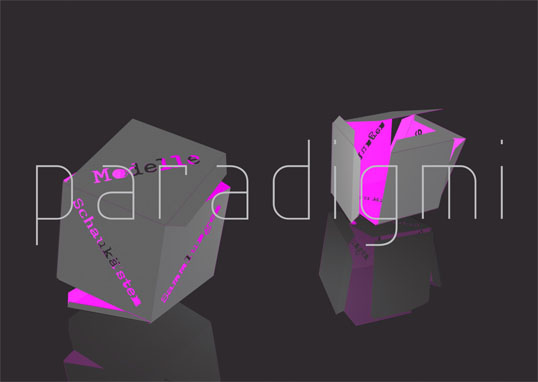paradigmi
26.08. – 18.09.2011
paradigmi
paradigmi exhibition workshop with German and Italian artists
Opening: 26 August 2011 / 7 pm
Exhibition duration: August 26 – September 18, 2011
Opening hours: Fri. – Sun. 16 – 20 h and by appointment
Paola Alborghetti (IT) milan dresden
Emilia Castioni (IT) milan
Nicola Felice Torcoli (IT) milan
Eckehard Fuchs (DE) dresden
Marta Fumagalli (IT) milan
Andreas Hildebrandt (DE) potsdam
Thomas Kabelitz (DE) berlin
Martin Mannig (DE) dresden
Riccardo Pirovano (IT) milan
Grit Ruhland (DE) dresden
with the documentation of HITCH HIKE: CARS OMEGNA (IT)
Silke Abendschein (DE) dresden
Davide Vergnano (IT) omegna
Twelve German and Italian artists show their and other world views in the group exhibition PARADIGMI. In the preceding workshop with the subtitle “Models – Showcases – Collections”, partly site-specific works are created for the Kunstraum geh8, which will be on view from 26.8. to 18.9. 2011. The basis of the exhibition is a mutual artistic exchange.
About paradigms
The winged word of the “paradigm shift” at the beginning of the 2000s may still be ringing in one’s ears. Without necessarily having anything concrete connected with it, one understands as soon as it is mentioned: obviously a great, far-reaching change is meant. Something fundamental, something ideological. In the 18th century, a “paradigm” was still understood as a determining scientific model of thought; today, in the narrower sense of the word, it refers to an “example”, “model”, “pattern” or “delimitation”, “prejudice”; in a more general form, it also means “world view” or “world outlook”.
But let us grasp especially the latter term – “Anschauung”. Anschauung is an epistemological term, which in its current usage is mostly related to Immanuel Kant. Kant refers to the sensual-receptive part of cognition (KrV B 33). What is meant, therefore, is not exclusively an optical experience, but one that includes the information processing and interpretation of all the senses. And this is what PARADIGMI is finally about: not about change – but about the view itself, the view of the world. Or more precisely, of different views or perceptions in “models – showcases – collections”. Perhaps one hears the change of the millennium (as Fata Morgana) thereby? Or simply as a mere illusion? The picture becomes the question (je-)of the single point of view – in the improbable, quantum mechanical puzzle.
About the form
What “models – showcases – collections” of world views could artists now have to offer in the midst of this interdisciplinary, fragmented, postmodern overload? First and foremost: aesthetic ones. And according to Kant, this is the basis of all our further knowledge – before the concepts. The constant reshaping and processing of sensory impressions – by one or more individuals, quasi through a human filter. With intuition to reduce the growing complexity – at least an attempt. Dividing the inexplicable with the incomprehensible, out comes something: which is not testable, not calculable and verifiable – and yet knowledge – of a different kind. Much has been thought and written about different brain hemispheres and their information processing, which is now considered obsolete. What remains, however, is the statement that one half of our thinking is “holistic, pictorial, musical, creative, intuitive, timeless, spatial, emotional and body-oriented” – even if most people spend a large part of their time typing keys communicatively in front of square machines. Besides, who decides on the necessity of “applying” an aesthetic reflection?
Showcase model, model project, model building board, model agency, mental models … a model is an object (…) that in important respects resembles an >original< (possibly yet to be created). In the natural sciences, a model is usually understood as a vivid idea of an unapparent phenomenon, which makes this phenomenon accessible, at least within certain limits, for calculations, predictions and explanations. In art they offer an exciting field of topics, because the debate about what is a "model" and what is an "original" has been an open question since the work of art in the age of its technical reproducibility. Furthermore, models generally enable a special, sensual insight through their adaptation to the human dimension, since they provide scaled-down and usually simplified images of the worlds of life and thought. The "showcase" overlaps with the model in subject areas. For example, it frames the idea visualized in the model. Thus it too "shows" its content in a certain way. It poses the question of presentation, of publication - as a frame, as a showcase, as a pedestal, as a display. He refers to his institutional setting. He does not present his content as mere, incoherent objects, but places them in a certain context. Be it in terms of content, discipline or institution. In doing so, the showcase resembles the camera's viewfinder and focuses on the object. In this way, it enables the concentrated viewing of individual aspects. Collections" are associated with "showcases". But at what point can one speak of a collection? How many objects must be present? In any case, a collection establishes relationships between things, objects, data. One or more properties must be common to the objects of a collection, because: collecting means the systematic search, acquisition and storage of things or information. In industrialized countries, collecting has become an idealistic occupation. Institutionalized collecting consists of creating collections in museums, libraries or archives. A collection continues to provide an overview of a subject. In art, things can be seen as belonging to each other, which contradict each other in everyday life. There will be partly site-specific works by 12 artists from Germany and Italy. The media spectrum ranges from painting and drawing to objects, installation and conceptual sound installation. The exhibition is sponsored by:
Landeshauptstadt Dresden, Amt für Kultur und Denkmalschutz, Ostsächsische Sparkasse Dresden
